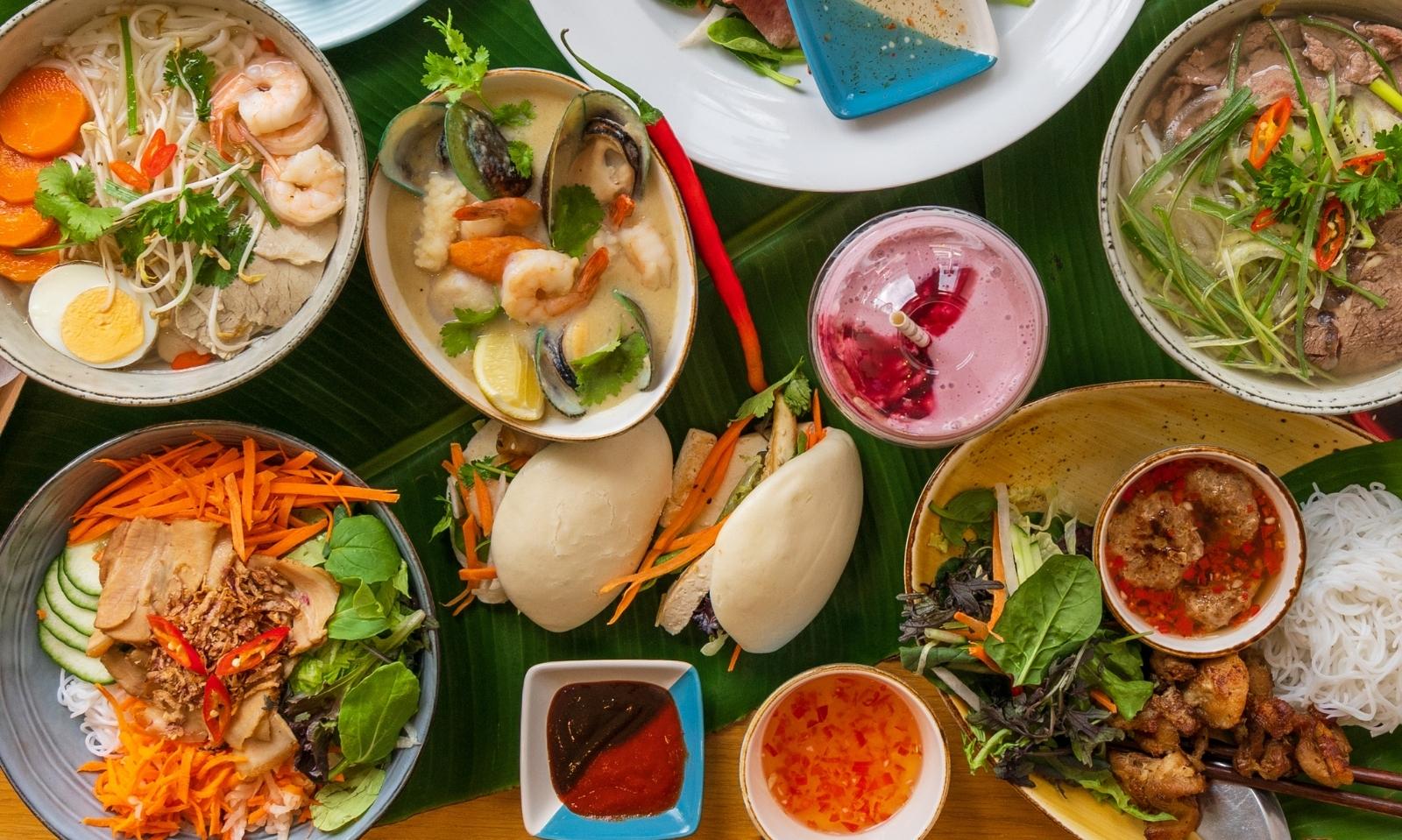Vietnam has long been known as a country with beautiful scenery. Aside from that, this lovely country spoils visitors with unique and tempting dishes that anyone who has visited cannot deny their passion for Vietnamese cuisine. Right now, we’re pleased to take you on a tour of 17 must-try Vietnamese dishes.
1. Bun Dau Mam Tom (Fermented Shrimp Paste Sauce With Fried Tofu And Vermicelli)
In Vietnam, Bun Dau Mam Tom can be easily found on every corner of the streets because of its simplicity but surprisingly great taste. However, it is said that only in Ha Noi can you savor the most original version of this street food. In the rush and bustle of big cities, sitting down and enjoying a plate of Bun Dau Mam Tom in a beautiful corner of this thousand-year capital will make your heart warm.
In the past, this tasteful must-try Vietnamese dish is made up of just three main simple ingredients: golden fried tofu, fresh rice vermicelli, and the stinky delicacy “mam tom”.
Moreover, to make sure that tofu pieces are still crispy, hot, and not burnt, the chef must be very skillful. Each piece of tofu must be selected carefully so that it is soft and white enough. The result must remain soft inside, the outside is golden brown, crispy and fragrant. However, as demand grows, Bun Dau Mam Tom nowadays includes many side dishes: pig’s trotter meat, fried spring rolls, pork intestines, and Hanoi’s specialty Cha Com.
Just enjoying such a serving of it, diners already feel they have had a delicious, cheap, and full meal.
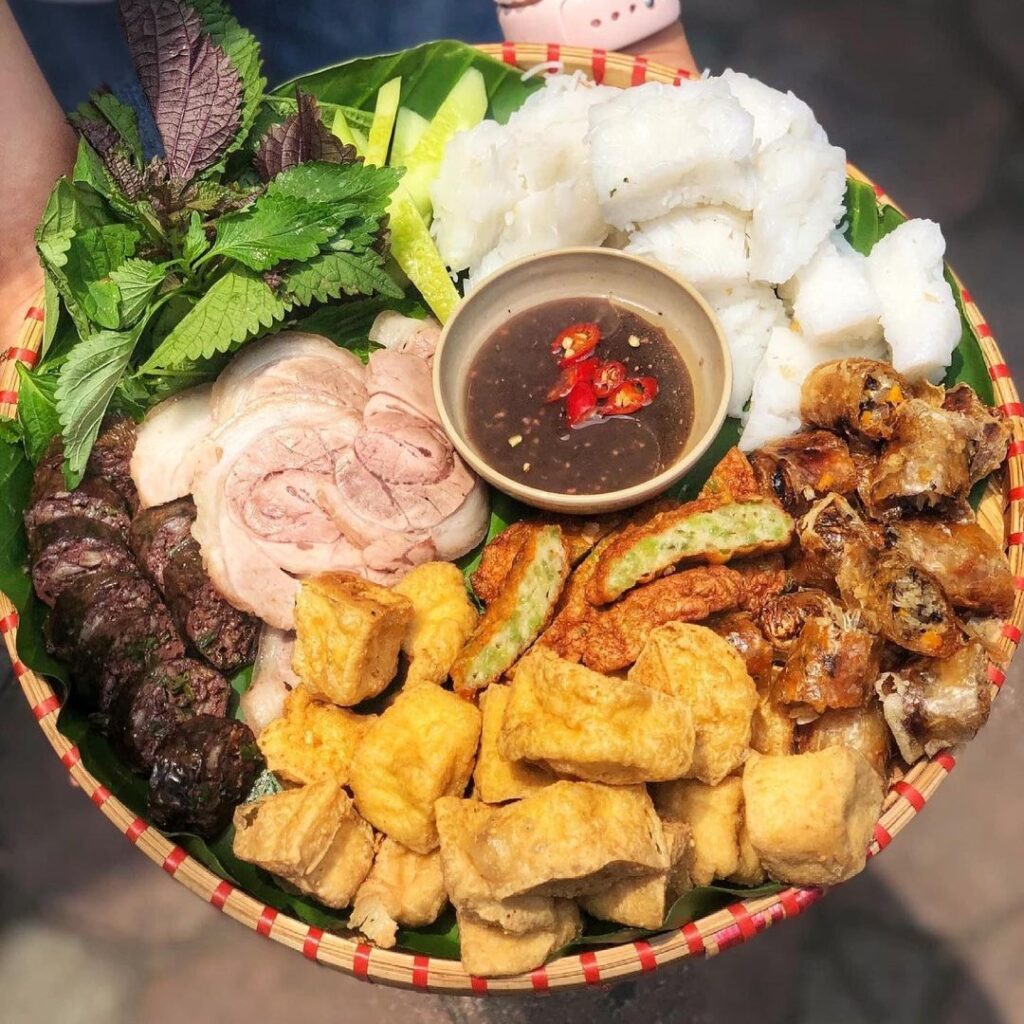
Further, the excellent combination of the bowl of shrimp paste dipping sauce, along with the pieces of fried tofu and the chewy, soft, and white vermicelli, makes this meal. In reality, hardly everyone can eat shrimp paste. In particular, foreign tourists who first adore this dish find the taste to be really unpleasant. But once they become used to it, they can only become dependent.
Visitors will enjoy the salty flavor of shrimp sauce, the sweetness of sugar, the sourness of lemon, and the heat of the chili. They all mix together, making them taste weird and tempting when eaten with other foods like vermicelli. After trying this dish just once, people will never forget how amazing it tastes.
2. Bun Thang (Thang Vermicelli)
As a delicate dish, expressing the elegant style of Ha Thanh cuisine, Hanoi Bun Thang has a perfect combination of color, aroma, and taste. These will attract diners at first sight.
First, the ingredients to make a bowl of Bun Thang are very simple, anyone can imitate and make it. The thing is, to bring up the essence and traditional flavor of this specialty takes a lot of dedication and subtlety. Therefore, Bun Thang is considered the most sophisticated dish of Hanoians.
Second, to make a bowl of Hanoi Bun Thang in the right style, the chef must be very picky and careful in every step, from choosing ingredients, preliminary processing, and processing to presentation. It is said that making a bowl of Bun Thang requires 12 types of ingredients. That is to say, the bowl is a synthesis of every small part in a subtle way to create the perfect taste.

Third, the main ingredient for making Bun Thang is a kind of vermicelli that is untangled and soft. The chicken is carefully torn into small slices but still has a little golden skin. Other components such as thinly sliced pork rolls, thinly sliced omelets, sweet but not fishy shrimp rolls, and sweet and sour shredded dried radish. There are also essential ingredients like shiitake mushrooms, spring onions, and finely chopped laksa leaves.
Last, one final important determinant of deliciousness is the broth. The broth is the core and soul of Hanoi Bun Thang. During cooking, the chef must skim the foam continuously and evenly so that the water does not turn cloudy.
Hanoi Bun Thang is delicious in taste and attractive in appearance. In the middle of the bowl is a circle of a dark yellow salted egg surrounded by golden fried eggs, lean pork pie, white chicken slices, and slightly yellow radishes, going with brown shiitake mushrooms and shrimp paste. On top are a layer of fried onion, scallions, and attractive slices of red chili. It would not be an exaggeration to say that Bun Thang is the harmony of heaven and earth when it includes all the bright colors of the four seasons.
Thus, this also is another beautiful must-try Vietnamese dish that you don’t want to miss.
3. Bun Moc (Meatball Noodle Soup)
About a century ago, Bun Moc first appeared in Hanoi. At the time, it was considered a high-class dish because it included meatballs, wood ear mushrooms, and shiitake mushrooms. The high standards of Bun Moc make it a delicacy. Making a bowl correctly is challenging since it has numerous components and the soup must stay clear and fresh.
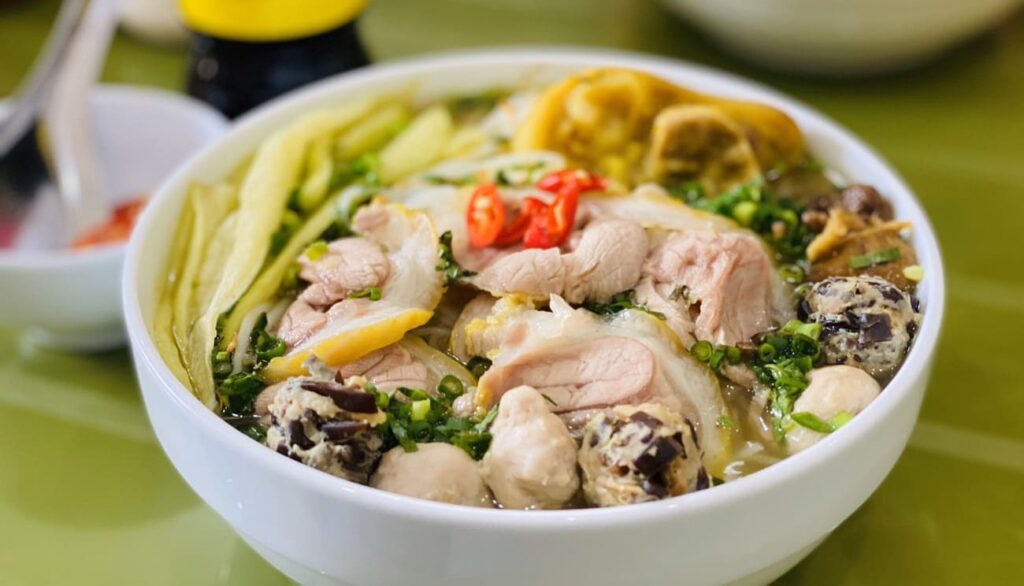
According to the sellers, the broth is cooked in two separate steps.
First, during the stewing process, the foam is regularly picked up so that the broth has a clear, natural taste and sweetness. Second, coming to the special character of the dish, standard meatballs are made from clean, finely ground pork, mixed with wood-ear mushrooms and seasoning. The balls are very well and evenly made so that it feels like sellers put all their love into making them.
The finished flavor of Bun Moc depends on some more different ingredients according to different shops such as pork bologna, chicken meat, dried bamboo shoot, quail egg, and herbs but it will be all delicious when combined together.
It is not hard to come across a crowded stall in a small corner with people sitting pretty close to each other, savoring their bowl of Bun Moc in the cold weather in Hanoi. It has become a special feature in the locals’ hearts and is an indispensable part of Vietnamese cuisine. Come and enjoy this must-try Vietnamese dish once to never forget the bold but sweet taste.
4. Xoi Xeo (Xeo Sticky Rice)
Xoi Xeo, one of the top 5 must-try Vietnamese meals in Ha Noi, is a fantastic mix-and-match breakfast for people from all walks of life, but particularly for students and manual laborers due to its affordable pricing (about 10,000 VND) and incredibly delicious flavor.
Further, Xoi Xeo is compared to the first rays of the morning sun due to its stunningly vivid yellow coloring. Besides, it is not only appealing in terms of color but also tastes good. Tasters’ noses will be struck by the perfume of fried onion and liquid fat as soon as the container is opened.
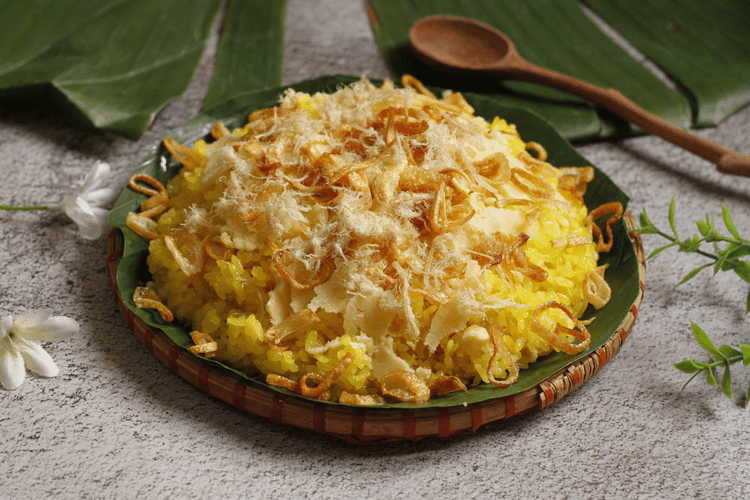
The techniques are fairly complex to obtain a genuinely fragrant packet of Xoi Xeo. It is considered the hardest sticky rice to make in Vietnam. Moreover, the rice used to cook Xoi Xeo is a type of rice that is glutinous but not crushed, eaten when hot, not flabby, and when cooled does not harden. After washing, the rice is soaked with turmeric water to produce a golden color.
Besides, Mung beans are what make Xoi Xeo more delicious and completely different from other types of sticky rice. First, the bean, after being carefully chosen and peeled, is steamed, mashed, and then rolled into small balls. The seller will use a knife to cut it into thin slices and drop it directly into a handful of Xoi. Second, to finish the taste, a spoonful of liquid fat and crispy fried onion is spread evenly on top of a Xoi Xeo, wrapped in banana leaf and old newspaper.
Xoi Xeo has now become the pride of Northern cuisine when presented in high-class restaurants. However, it is a traditional Vietnamese street food that Hanoians still prefer to eat this food sold on the sidewalk, like in the old days. In the cold weather of the autumn wind, enjoying a simple, fragrant pack of Xoi Xeo on a corner of Hanoi has become a special feeling for Hanoi lovers.
5. Banh Dau Xanh Hai Duong (Hai Duong Mung Bean Cake)
Vietnam’s various regions where have distinctive cuisines. Vietnam’s Mung Bean Cake, which has a sweet and fragrant flavor, has long been a well-known treat both domestically and abroad. Also, it is frequently served in gift baskets and on plates of cakes to welcome visitors.
Mung bean cakes are simple to make, but they contain special family recipes from the Northern countryside. Mung beans, sugar, and a well-chosen fat or cooking oil are the ingredients for this cake. Even though the cake has only just a few ingredients, baking it effectively is extremely challenging.
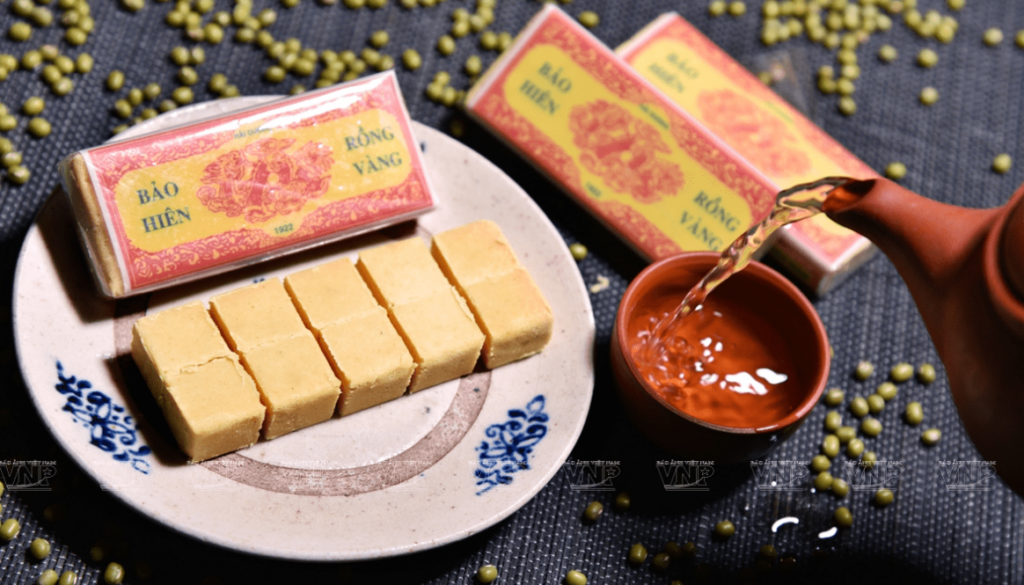
The ingredients are handled with extreme care right from the start. Raw materials like mung beans and sugar must have a known origin, be subject to quality control, and follow set standards. Also, the beans must be equally ripe, not moldy; usually, the type with the yellow core is the best. Mung beans are roasted in a modern production line to ensure cleanliness. After roasting, the beans will be separated from the shells, ground into a fine powder, and mixed with other ingredients to make cakes.
Currently, Hai Duong Mung Bean Cake is famous among local consumers and has been exported to many nations across the world. The cake has a sweet and greasy flavor with a fragrant mung bean fragrance. When you put one piece in your mouth, it dissolves instantly, leaving you with a fascinating and unsatisfied feeling of wanting more. You simply do not want to pass up the opportunity to eat this unique dish while in Vietnam.
6. Lau Cua Dong (Freshwater Crab Hotpot)
As the name hints, Freshwater Crab Hotpot is a hotpot with field crabs as the main component. Minced crab is a rural cuisine that is popular throughout Vietnam. Furthermore, the nutrition of field crabs is extremely rich, particularly in calcium. As a result, each region in Vietnam has its own processing methods based on regional tastes. Previously, using field crabs in hotpots could only be found in Hai Phong, where the ingredient is very popular. However, this type of hotpot has now spread beyond the borders of Hai Phong to be enjoyed by diners throughout Vietnam.
Freshwater Crab Hotpot is a savory dish that is perfect for a cold day too. The most complicated and time-consuming part of making this hotpot is the preparation of ingredients. The cook must select crabs of approximate size and shape, as well as other ingredients. They are tomatoes, vinegar, fish sauce, shrimp paste, seasoning powder, Gac fruit color, crispy fried tofu, vegetables (such as spinach, banana flower, banana stem, shredded water spinach, lettuce), vermicelli, and a pot of broth.
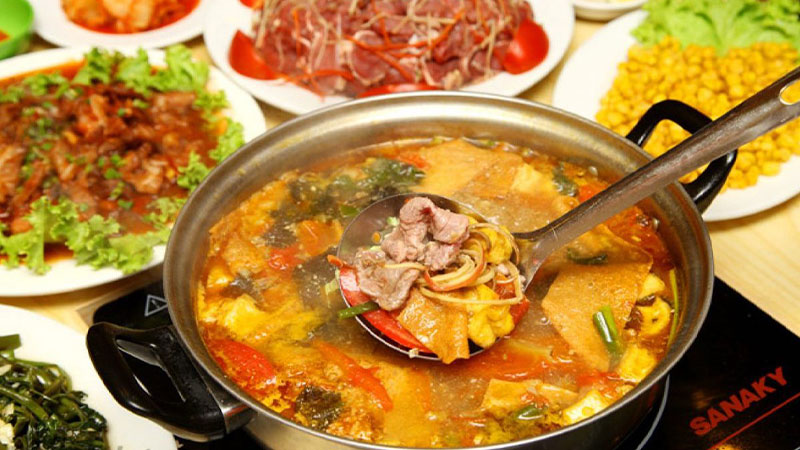
It is impossible to enjoy crab hotpot without mentioning the associated meat side dishes such as beef, pork, or shellfish. The crab’s sweetness permeates each fiber of the meat, leaving a sweet sensation on the tip of the tongue. In addition, we can dip pork intestines, duck eggs, and mushrooms. Thus, looking at the dishes presented around the hotpot in a harmonic and beautiful manner, rich in colors and enticing flavors, is enough to stimulate all of the senses.
Freshwater Crab Hotpot combines the rich sweetness of field crabs and the fragrant aroma of crab roe with the mild and elegant sour taste of vinegar and the bright red color of tomatoes. Sitting beside an emitting steam crab hotpot with thin smoke rising from the ethereal sweet smell of crab roe mixed with salty and spicy broth is enough to make people eager to eat and sweat. The dish must be on the list of must-try Vietnamese dishes.
7. Com Hen (Hue Clam Rice)
Have you ever heard of Ancient Capital Hue? This place used to be Vietnam’s Capital in the past and is absolutely one of the most worth visiting places in Vietnam. Besides many tourist attractions such as Hue Imperial Citadel – one of Vietnam’s seven UNESCO World Heritage Sites, Thien Mu pagoda, and many historical relics, Hue is also famous for its cuisine which used to be served for the royal dynasties.
Nowadays, Bun Bo Hue is the most mentioned dish when thinking about Hue, but there is one dish that local people here cannot live without, which is Com Hen, a simple but stunning dish of rice.
Com Hen includes overnight leftover cold rice, stir-fried clams, and clam broth, that’s all. However, do not rush to disregard it. To make the famous ancient capital’s soul dish, the preparation stage is very meticulous. From clams, chili sauce, pickled chili, and fish sauce to dozens of other flavors, all must be carefully prepared to make a bowl of harmonious clam rice.
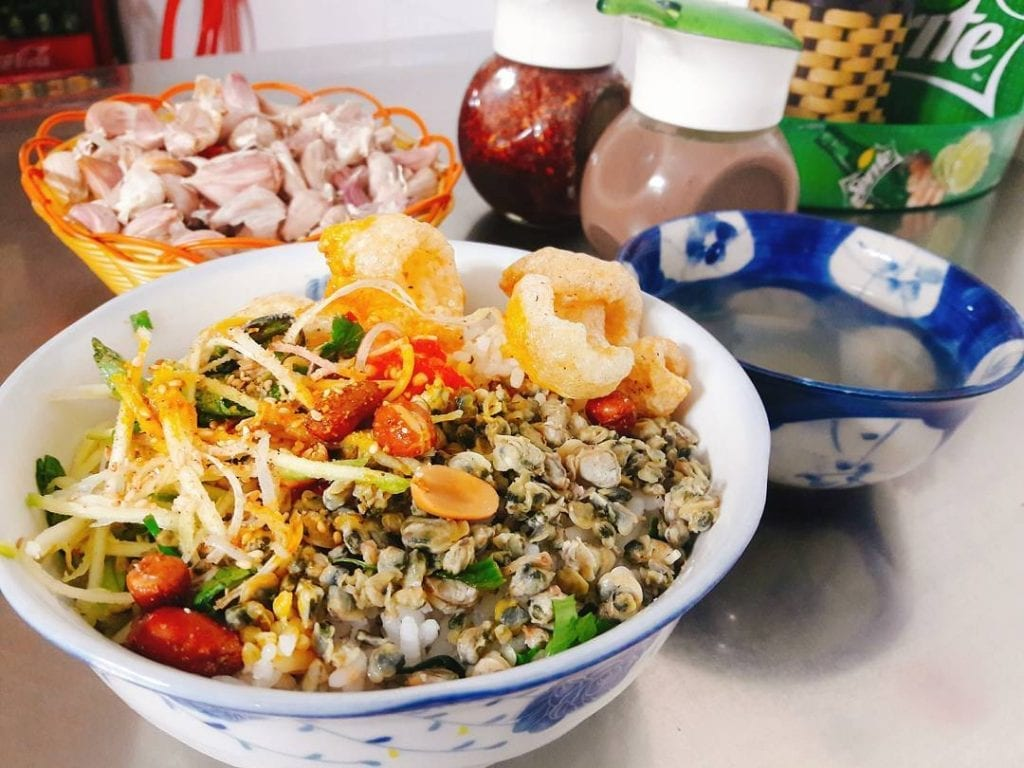
First, people soak clams to get rid of the dirt, thoroughly clean them, and boil them before removing the shell. After marinating with seasonings, the meat is stir-fried with oil, chopped onions, chili powder, and fish sauce. After boiling again, the soup is seasoned with Hue shrimp paste, sugar, ginger, and salt. Second, stir-fried clams are combined with rice, herbs, toasted peanuts, star fruit pieces, sesame seeds, and pig cracklings in a bowl. To improve the flavor, add shrimp paste and chili.
Also, the ideal mix of freshness and sweetness of clams, the spice of chili, the amora of herbs, the crispiness of pork cracklings, and peanuts with rice would melt your heart. This unusual and intriguing flavor of rice dishes can be found nowhere else in the country. It is the pride of Hue residents and the country as a whole. Do not leave Vietnam until you have tried this specialty.
8. Mi Quang (Quang noodles)
Referring to the cuisine of Central Vietnam, many people often think of Quang noodles, a specialty that is named after a tourist attraction province, Quang Nam. This is a dish that can cause nostalgia and attachment for diners while enjoying it.
Quang noodle is composed of rice as well, but it has their own distinct nuances and flavors. Rice should be firm and soaked for at least one hour. It will then be milled and coated in tiny layers. Finally, the layers will be stacked and chopped into noodle stalks. Following that are a variety of things to spice up a bowl of Quang noodles: shrimp, chicken, pork, beef, snakehead fish, crab, and so on. Depending on the cook, these components may occur in the dish. Regardless of its various varieties, Quang noodles are not complete without roasted rice paper, green chilies, lemon slices, roasted peanuts, and a platter of raw veggies. Mixed greens to eat with Quang noodles are usually baby cabbage with thinly sliced young bananas, cilantro, Vietnamese mint, and Thai basil.
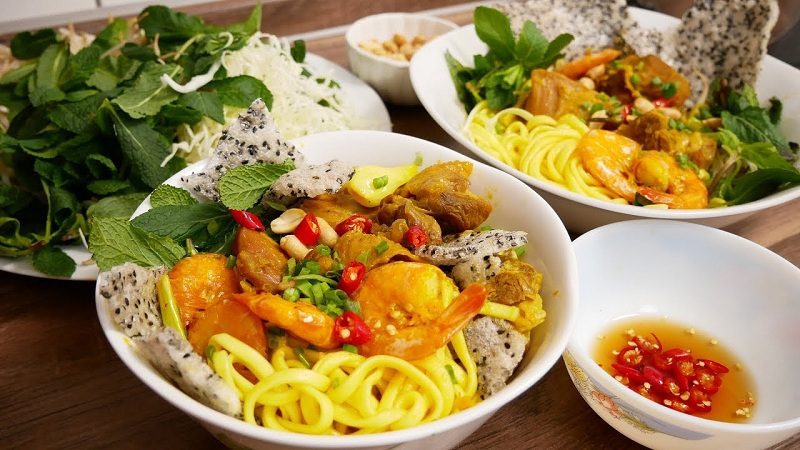
Further, Quang noodles are best eaten at lunchtime. Pick up a chopstick of noodles, bite a piece of hot chili, then take a sip of the broth to produce a lovely sound to realize why Quang Nam people cannot live without this dish. However, in order to fully appreciate the dish, it must be eaten using rice paper. This unique ingredient imparts a crisp and fragrant flavor, and the fat of the grease combined with the nuttiness of the baked rice wonderfully complements the flavor of Quang noodles.
The Quang noodle is now well-known throughout Vietnam’s south and north. It has become a typical dish of the entire Central area, appearing in every single meal of the people who live here as a habit, a lifestyle. It is also a one-of-a-kind attraction that draws travelers every time they have the opportunity to visit this beloved country.
9. Banh Canh Ca Loc (Snakehead fish noodles soup)
Banh Canh Ca Loc is one of the most popular and must-try Vietnamese dishes in Central North Vietnam, especially in Quang Tri province. It is loved and enjoyed by all local residents at any time of the day.
This traditional Vietnamese dish consists of banh canh (noodles), ca loc (snakehead fish), broth from the fish, and various herbs, particularly scallion and cilantro. Quang Tri locals make Banh canh with both regular rice flour and dark rice flour. They are soaked together until soft, then crushed and kneaded well. People then use narrow bamboo tubes to chop them into small threads. As a result, when cooked, the noodles are slightly opaque and rougher than other types.
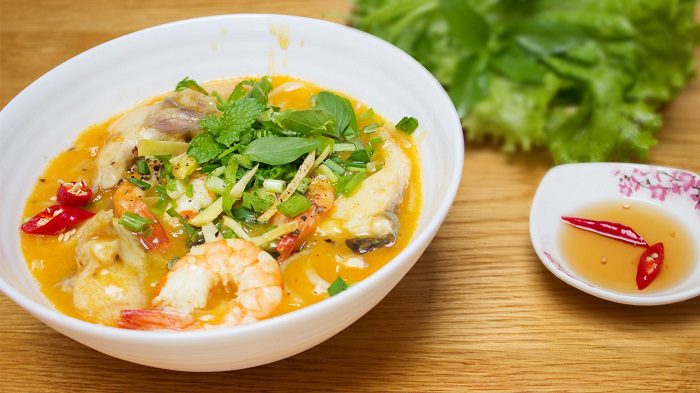
After that comes snakehead fish. This kind of fish is usually found in rivers, fields, or ponds. In the dish, it will be steamed until just cooked, after that the fish will be deboned. The next step is to stir-fry the meat to an attractive golden color. Fishbones are used to puree into the pot of broth. Therefore, the broth has the natural sweetness of the fish.
Also, snakehead fish noodles are best when eaten hot right after being scooped out from the pot. While preparing a bowl of noodles, sellers often sprinkle a little spicy chili powder to enhance the flavor. The standard bowl of Banh Canh Ca Loc must meet these requirements: soft, chewy noodles, fatty and golden color fish meat, especially the rich broth must still retain the freshly sweet taste but not be fishy.
Nowadays, you can enjoy snakehead fish noodles everywhere in big cities across the country. However, the taste in Quang Tri still has its own characteristics. If you have a chance to stay in Central Vietnam, spending a little time savoring a bowl of Banh Canh Ca Loc will make your trip to this beautiful country unforgettable.
10. Com Ga Tam Ky (Tam Ky Chicken Rice)
If you are traveling to the South Central Coast of Vietnam and looking for some famous dishes there, Com Ga Tam Ky must be the top one on the list. Tam Ky chicken brand in Quang Nam province has a reputation all over the country. The way of cooking the chickens is very typical and full of Central flavor.
Along Tam Ky town, there are dozens of chicken rice stalls and almost every place is busy with customers coming in and out. Because it is a chicken dish then obviously the main ingredient is chicken, but it must be Tam Ky chickens. Chickens in this hot and sandy area have to struggle to find food, so the meat is firm, and the skin is thin. The chicken after being processed has golden skin, each muscle fiber is sweet and fragrant. The chicken broth is for cooking with rice, which is why the finished rice turns golden yellow and has a very attractive shine.
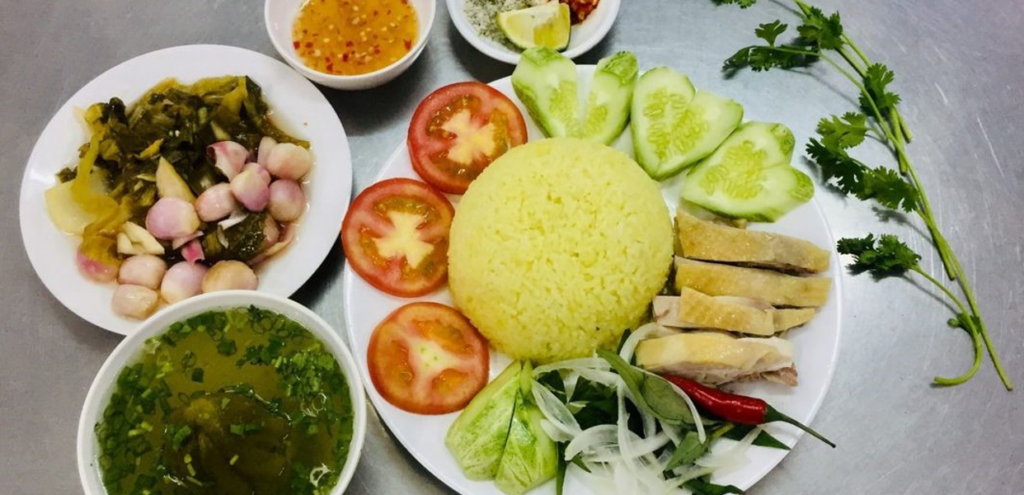
A Tam Ky Chicken Rice plate has all eye-catching colors: turmeric yellow rice, the ivory color of chicken, red tomato, green cucumber, and purple onions, all of which are local products. Therefore, the delicious plate of chicken rice contains the quintessence of Quang Nam.
It is indispensable to enjoy the dish with sour and sweet pickles that even the pickiest eaters can hardly ignore. Also, the pickles neutralize the greasy taste of chicken rice, making the dish more delicious and attractive. Non-spicy eaters may be afraid of the red color of chili being spread all over the plate. However, for local people, the spicy taste of chili is indispensable in the dish.
Currently, Tam Ky Chicken Rice is very famous and available in many big cities, but it is not until Quang Nam can diners fully feel the special taste of this dish. Is that why anyone who has the opportunity to set foot in the Central region always tries to linger a little bit longer just to enjoy this extraordinariness?
11. Banh Dap (Dap Cake)
Banh Dap, a rural but unique and tasty cake, may be found in the central regions of Vietnam, from Da Nang to Khanh Hoa, from street vendors to district markets.
Despite being a rural dish, it is prepared in a fairly complex manner. If you purchase this dish from a street vendor, you will be able to witness the process of producing the famous Banh Dap firsthand.
The owners of these shops are often elderly mothers. According to many people, the processing of this dish requires a lot of experience and sophistication. In addition to the pre-baked rice paper, steamed thin rice pancakes are always made instantly to serve diners because only when it is still hot can the dish retain all the delicious flavors.
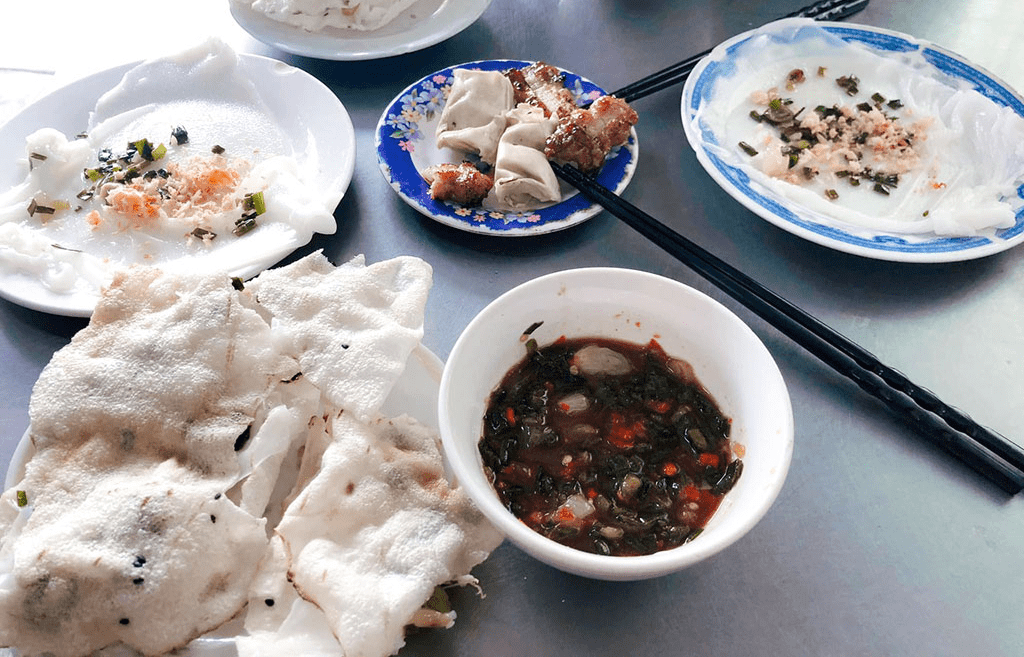
First, the flour mixture to make steamed thin rice pancakes is made from soaked and pureed rice. Before being steamed, rice flour is mixed with water in a certain ratio so that the slurry is not too thin or too thick. Second, the mixture must be gently stirred by hand so that the products will be soft and silky. The seller will then scoop out a spoonful of the flour mixture and spread it evenly on the cloth of the boiler. It only takes about 2 minutes to cook a pancake, then it will be skillfully unloaded by using a thin bamboo stick.
Further, the pancake is then spread on top of the baked rice paper with onion fat put evenly on top. At this time, you finally can enjoy a hot, both crispy and soft, fatty, and delicious Banh Dap. Nowadays, people also eat the dish together with grilled meat, boiled meat, or pig’s intestines. When savoring the cake, it is indispensable to have it with a cup of fish sauce seasoned with the typical spicy taste of the coastal land. First, fold the cake in half, dip it into fish sauce, and there you go. The crispiness of the rice paper and the softness of the steamed thin rice pancake blended together with the richness of the seasoned sauce and the fragrant grilled meat bring a very unique and interesting taste that you will never forget.
If you have the opportunity to travel to the central coastal provinces in Vietnam, in addition to visiting gorgeous sceneries and enjoying rich seafood dishes, keep in mind to look for and taste this rural Banh Dap once.
12. Ca Phe Sua Dua (Coconut Coffee)
Vietnam is famous for its coffee. Despite its notoriety for the unique Ca Phe Sua (coffee with condensed milk), Coconut Coffee has a special place in its inhabitants’ hearts. This must-try drink can be found in many major cities, particularly Sai Gon and Ha Noi.

This drink is traditionally created with three ingredients: Vietnamese ground coffee, coconut milk, and sweetened condensed milk. It’s a blended coconut slushy with a strong brewed Vietnamese coffee on top. Coconut Coffee exists in between a drink and a dessert. The creamy sweetness of coconut milk does not dilute the richness or bitterness of coffee, but rather produces an appealing flavor symphony that entices coffee drinkers to return for more.
If you enjoy coffee and coconut, one sip of this delicious drink will have you in pleasure.
13. Hu Tieu Go (Street Noodle Soup)
Coming to Vietnam without trying noodle soup, especially the kind of noodles carried on trolleys in every corner of the Central South of Vietnam, is a huge regret. The word “go” means the sound that all Vietnamese growing up listening to “knock knock knock” of the noodle trolleys, the sound of people making money, and the sound of bustling life.
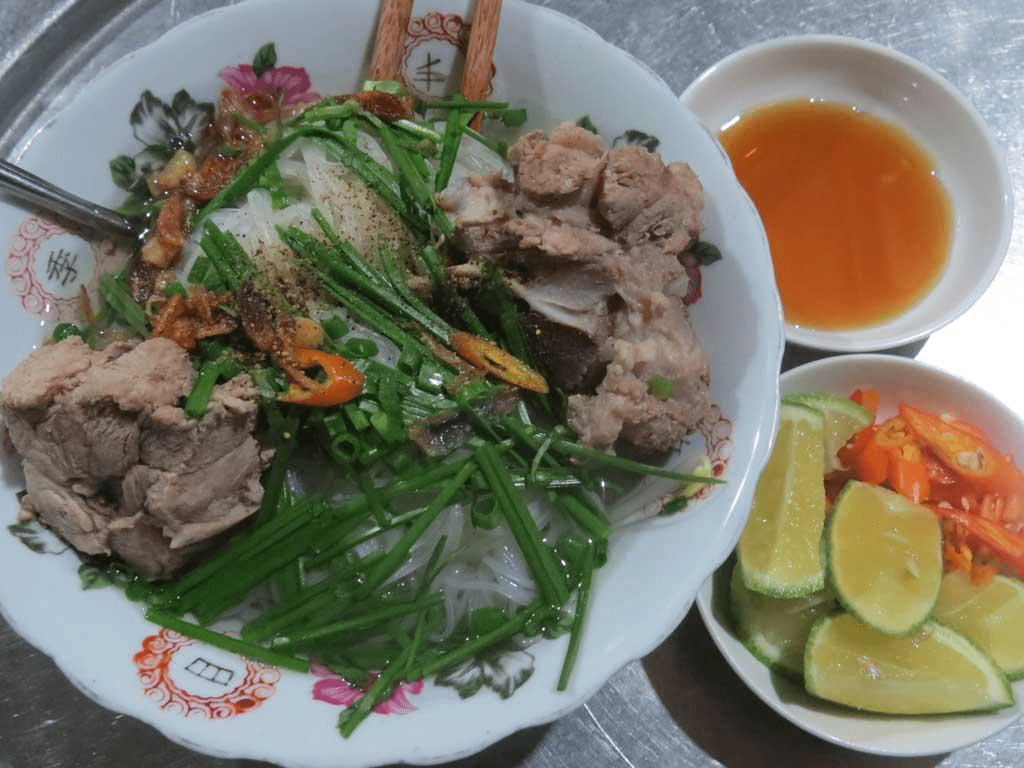
Also, this type of noodle is typically sold in the afternoon and evening for a fairly low price of about
20.000 – 25.000 VND/bowl. Noodles, pork, meatballs, wontons, broth, and coriander are the key ingredients in this dish. Scrap and fried onion are two particular garnishes that make this dish delicious. These two are placed on top of the dish for decorative purposes only, but they taste incredible. Moreover, the broth is clear but tasty. People frequently taste the soup first, then add some fresh chile, lemon, and soy sauce, and then the noodle bowl is ready to be appreciated.
Street Noodle Soup attracts everyone by its simplicity but boldness, it is hard to resist and addictive. This dish can be found on nearly every street in Saigon. It is one of some must-try Vietnamese dishes. If you really want to explore the essence of Vietnam, you simply cannot ignore this specialty.
14. Bun Rieu Cua Dong (Minced Crab Vermicelli)
In Vietnam, regardless of the cold weather or hot summer days, freshwater minced crab vermicelli still can satisfy the most fastidious customers because of its rich flavor with slightly sour broth and subtly smell of field crab. You can easily find the dish wherever you are in this S-shaped country.
Bun Rieu Cua Dong is a simple dish. It is simple to create but takes attention to detail. It frequently takes a whole day of ingredient preparation and processing to prepare a wonderful bowl of Bun Rieu Cua. People must capture crabs from paddy fields in order to make excellent crab noodles soup. Field crabs must be washed and peeled after capture. The roe will then be extracted from the crab’s shell using a chopstick or a small spoon. Male crabs are said to have more flesh than female crabs.
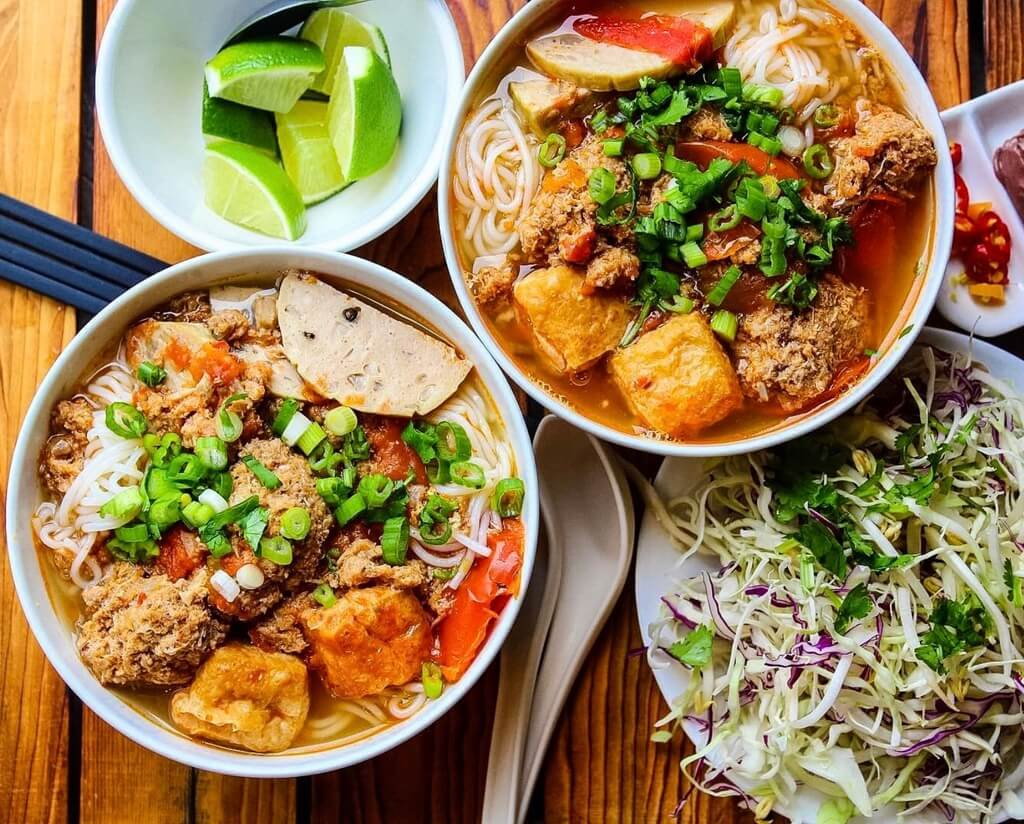
The crab body is pureed with water after the roe has been removed. The crushed crab liquid will then be filtered into a cooking saucepan over medium heat. While the crab pot is heating up, the cook will combine ground meat, egg yolks, onions, garlic, and spices with the previously separated crab roes to form exquisite crab paste. After the crab pot is boiled, we have floating crab flesh (Vietnamese people call it “rieu”), which is quite good and makes the dish unique.
A tasty bowl of Bun Rieu Cua Dong is frequently served with a plate of raw herbs. In any weather, the taste of sweet and salty crab broth blended into each thread of vermicelli makes people feel light and invigorated. It is not an exaggeration to state that this is one of Vietnam’s national spirit dishes.
15. Ca Loc Nuong Trui (Grilled Snakehead Fish)
Nature has blessed the Southwest of Vietnam with an abundance of freshwater fish species. There is a saying that this is a region where rivers are teeming with fish and fields are teeming with shrimp. In terms of the most popular fish, the snakehead must be highlighted.
Snakehead fish is a very popular freshwater fish in Vietnam, also favored by Vietnamese people and very often used in daily meals. Although there are many dishes with delicious fish, to experience the fullest flavor of it, only Grilled Snakehead Fish wins.
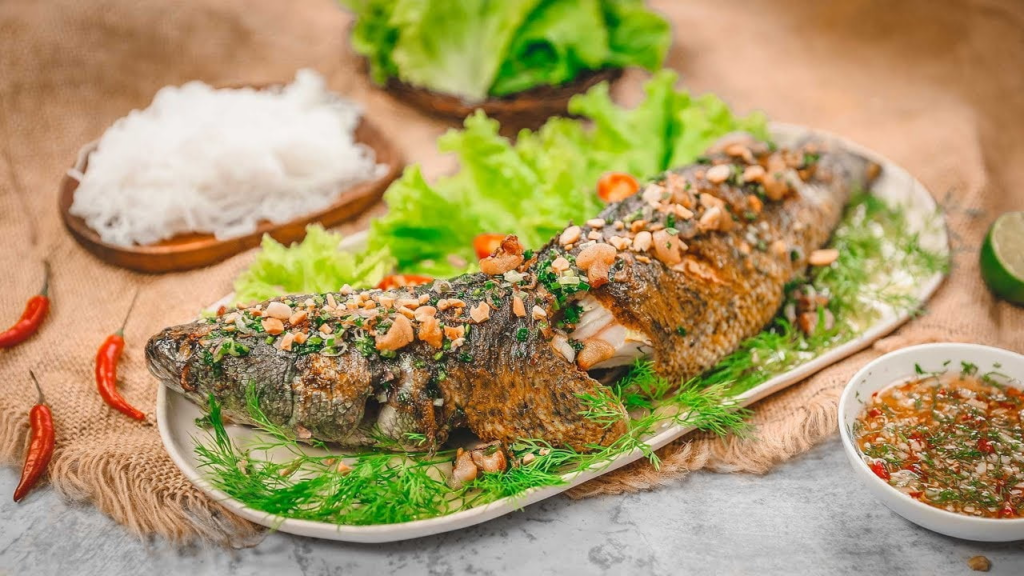
Because grilled snakehead fish is a rustic dish, preparation is simple. However, in order to create a tasty grilled dish, the cook must be sophisticated and creative. To begin, they only select incredibly fresh snakehead fish taken in the river, without fussy preparation, dissection, scaling, or even seasoning. After that, a clean bamboo skewer is required. The fish will be twisted straight from the mouth to the tail. The bamboo pole with the attached fish will then be placed in the ground and covered with dried straw. The amount of straw used to cover the fish must be sufficient such that when it burns out, the fish is only slightly cooked.
It’s time to eat the flavorful Grilled Snakehead Fish. Brushing off the ash from the fish, placing it in a large dish, and then slicing the fish’s body in half along the back. The fragrance of grilled fish enters the noses of tasters with an exceedingly fragrant perfume and a mild bitter smell of straw smoke from here. Soft and fatty grilled fish meat with a great flavor dipped in sour and spicy fish sauce, then eaten with rice paper, vermicelli, and fresh veggies creates an appealing experience.
Grilled Snakehead Fish is a simple dish made from everyday ingredients, but this dish is the taste of the countryside, of the river, and of people in the Southwest of Vietnam. Sometimes, just gathering around a tray of Grilled Snakehead Fish in the afternoon, sipping a cup of spirits, and chatting about everyday life is already so meaningful and heart-warming.
16. Bo Bay Nui An Giang (Beef From An Giang Seven Mountains)
The Bay Nui cow, also known as the Bay Nui racing cow, is a Vietnamese cattle breed raised in the Bay Nui district in Tri Ton, An Giang. It is a Bay Nui region purebred cattle breed. Bay Nui racing cows are currently at risk of extinction due to the practice of castration of bulls before adulthood, as well as a program of artificial crossbreeding with beef cattle.
The cattle breed of Bay Nui An Giang is familiar to the people of the Southwest and has entered the tradition with martial spirit races in the Bay Nui bull racing festival. In tradition, the winning pair of bulls brings the whole family a lot of joy and luck. After winning, the pair will not be killed nor sold but kept as a valuable asset of the family.
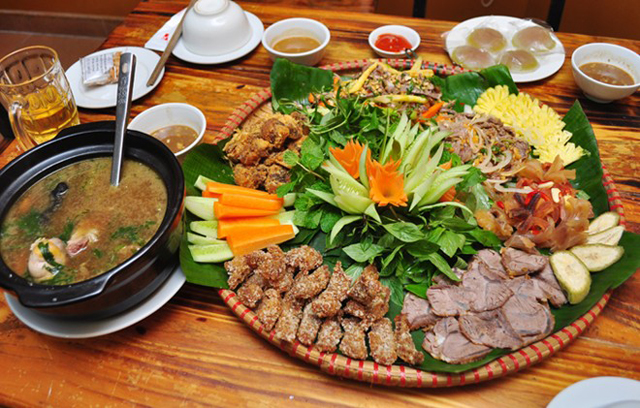
Walking down the alleys at the foot of Sam Mountain, one of Chau Doc’s many iconic mountains, visitors are drawn to eateries with the sign “Seven-course beè.” This is one of the specialties that draw visitors to Chau Doc, An Giang. Boiled beef intestines, boiled beef with banh hoi (a vermicelli dish), beef head porridge, sliced beef with bread, stir-fried beef with wine leaves, steak, and sauté diced beef are all part of the “seven-course beef.”
The main ingredient in this “seven-course beef” is beef from the Bay Nui region. Bay Nui meat is tender and delicious. As a result, no matter how the beef is processed, it is simple to make people desire to consume more. When creating “seven-course beef,” individuals rarely buy ready-made beef at the market, instead opting for a whole heifer. Sam Mountain’s Seven-course Beef is believed to be famous in part because of the fresh ingredients used, as well as the sauce’s distinct flavor. Fish sauce for dipping must be seasoned sauce blended with minced pineapple and the secret of rich spice. However, this dish will be less delicious without the accompaniment of vegetables such as celery, and onion along with various and regionally mountainous vegetables.
Although each of these Seven Beef Dishes differs in some auxiliary components, they all feature the typical flavor of beef from the Bay Nui region. Many people fly to the Southwest and visit An Giang solely to witness this sacred region and to sample the uniqueness of Sam mountain seven-dish beef.
17. Dua Sap (Macapuno Coconut)
Tra Vinh, about 130 kilometers from Ho Chi Minh City, is a Mekong Delta coastal province known for its specialized fruit plantations. One of the most well-known fruits of this land is Dua Sap, a highly peculiar form of coconut since its entire inside contains very little juice, instead filling with dense jelly-like flesh.
Tra Vinh, Cau Ke district, has long been well-known as the Southwest’s one-of-a-kind “Macapuno capital.” Nature’s gift, only this district can produce many Macapuno Coconuts, which are famous for their excellent taste. According to Cau Ke growers, even though a tree produces dozens of fruits, just one or two of them are Macapuno Coconuts. As a result, producing this type of coconut involves a lot of chances; some people become billionaires, but others don’t.
Externally, Macapuno Coconut looks very similar to other types of coconut. When you open it, the first thing you’ll notice is that the flesh is incredibly thick and has a strong aroma. If you’re lucky enough to find a tasty one, the jelly-like flesh will cover practically all of the coconut. This unusual form of coconut has a layer of very soft wax generated from coconut juice in addition to flesh.

Macapuno Coconut should not be drunk to quench thirst in hot weather, nor should it be eaten in a hurry to satisfy hunger. To appreciate it, you must understand how to savor the essence of this one-of-a-kind fruit. Local Southwest inhabitants eat in a rustic style with strong regional influences. After removing the shell, they will scrape the jelly-like flesh into a glass, and top it with Vietnamese condensed milk, shaved ice, and peanuts.
Unlike smoothies, where all components are combined, making it difficult to identify different flavors, a cup of Macapuno Coconut will have a distinct taste from fatty flesh that emits a sweet and rich aroma, the nutty flavor of peanuts, and the thrill of shaved ice. You’ll be nostalgic after eating it and can’t wait to dive right into the second cup.
Because it is a rare specialty of Tra Vinh, the price of Macapuno Coconut is quite expensive for food lovers. However, anyone who has ever eaten this type of coconut has the same comment: it is not exaggerated to say that Macapuno Coconut is indeed the pride of Tra Vinh.
Conclusion
Which food do you prefer after being brought from the North to the South to sample some of the must-try Vietnamese dishes? For the Vietnamese, these foods represent the country’s national character, a very traditional and sacred heritage that our forefathers passed down to future generations and have been kept to this day. They are the pride of the entire country.
